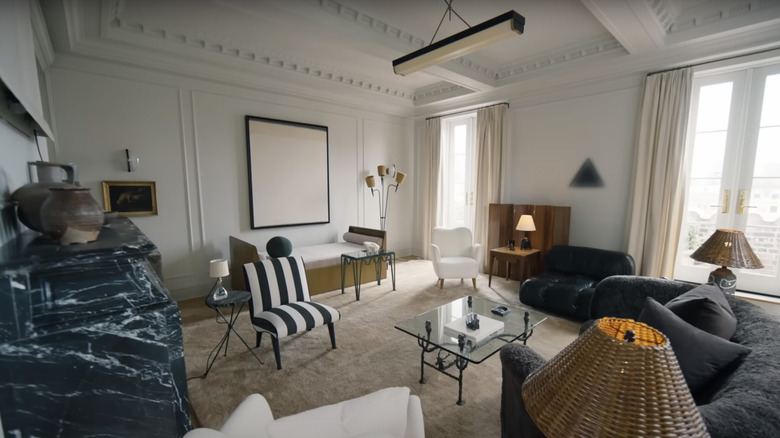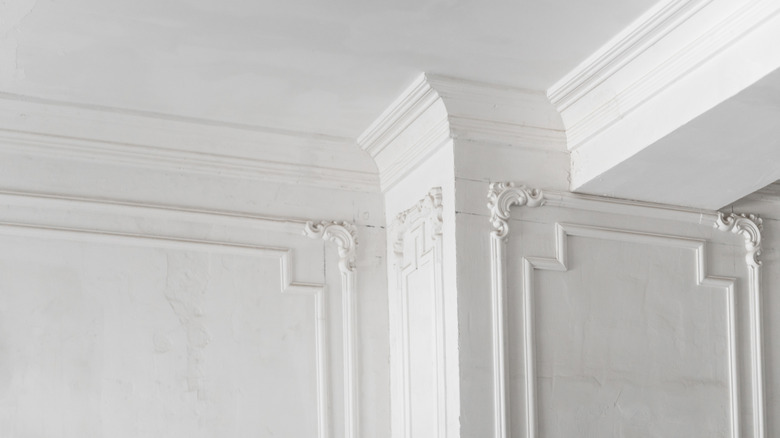Nate Berkus' Stunning Design Details Are No Passing Trend: Here's How To Get The Look
Layered. Unexpected. Vintage. These are just a few of the ways one could describe interior designer Nate Berkus' personal style. "I have an absolute fascination for things, and objects and spaces and places that have stood the test of time," the HGTV star told Homes and Gardens. Fans were recently treated to a little tour inside Nate Berkus and Jeremiah Brent's stunning home when Berkus posted a few stunning Instagram pictures of the power couple's living room. The neutral walls quietly support the wooden furniture and seating, predictably upholstered in their signature cream and black hues. But fans were most enthralled with the level of texture achieved throughout. Berkus accomplished this not just by layering unexpected furnishings with vintage silhouettes, but by also embracing highly decorative pre-war wall trim and crown molding, which are stunning design details that are no passing trend.
To learn more about the pre-war style and how you can incorporate it with trim in your own home, Mark Johnston, Founder of Historic Design Consulting, gave us the rundown. "Pre-war trim refers to the decorative molding featured in homes of various architectural styles built between 1900 and the beginning of the Second World War," Johnston explained during his exclusive interview with House Digest. "It marks the transition from the elaborate and complex millwork of the Late Victorian era to simpler and more elegant aesthetic of the Colonial Revival, Craftsman, Art Deco and Streamline Moderne styles." Because of this juxtaposition between the simple and elegant, pre-war crown molding like that found in Nate Berkus and Jeremiah Brent's New York City home is among the trim types that will improve the appearance of any room.
Use existing pre-war trim if possible and scale anything new to match
From wallpapering his daughter Poppy's bedroom with a playful pink print to covering the kitchen walls with chalky textured plaster, Nate Berkus carefully renovated his family's Greenwich Village home to mix very traditional elements with modern surprises in every room. During his exclusive interview with House Digest, Mark Johnston agreed with that approach. "When restoring an interior with pre-war trim it is important to understand the original design intent and aesthetics," he said, adding that it's necessary to get the proportions just right. "Many recent restorations ignore rules of proportion ... This can upset the balance of a room and make it appear awkward." Johnston cautioned against adding crown molding or baseboards that are too thick, window or door casings that are too wide, and wainscotting that is too tall.
The historic design expert also said it's important to choose the perfect color for your trim. Nate Berkus opted for a color washing effect that extends the light, neutral wall color and sheen to the elaborate crown molding and wall trim in his living room. But according to Johnston, a new coat of paint may or may not be the ideal approach if you're working with authentic pre-war trim or moldings. "It is best to retain the original varnish and finishes, when possible, as the years of patina add to the beauty of the molding." He said. Johnston suggests cleaning and repairing original molding, but added that you may need to strip several layers of coating to reveal intricate details or shadow lines. "Take precautions for the hazards of lead paint," Johnston cautioned.
How to get the pre-war look in a new home
So what should you do if you live in a brand new house, but want to recreate the look of Nate Berkus's pre-war trim? According to Mark Johnston, you should start by looking through period millwork catalogs. Along with helping you to get a sense of the right proportions for your home, Johnston exclusively told House Digest that they can help you "see how designers understood the aesthetics and ornament of the interwar period." Along with wall and crown molding ideas, the research phase may also inspire ideas for built-in cabinetry and textured plaster. Once you've found a pre-war design you really love, there are two options to consider. "Specialty molding manufacturers still produce some of the older molding profiles in a variety of species of wood stock," Johnston said. "Big box stores also carry molding profiles in stock which, although not exact copies, can be easily modified to resemble pre-war trim."
According to the historic renovation expert, after deciding on a pre-war trim profile and finishing up your installation, finish, color, and lighting are important choices to keep the look elevated. He recommended metal finishes, like antiqued brass or nickel, if you have or want to replicate the look of a craftsman or eclectic style home from the 1920s. But when art deco or streamline moderne are more your style, stick to polished steel or aluminum. "Period paint colors also give harmony to the interior and give a cohesive look," Johnston suggested. Last but not least, he recommended adding lighting that will "highlight the shadow lines and visual interest of pre-war trim."


